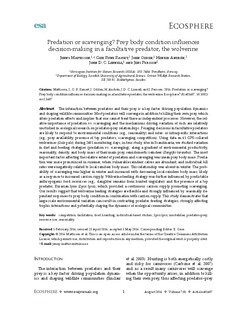Predation or scavenging? Prey body condition influencesdecision-making in a facultative predator, the wolverine
Mattisson, Jenny; Rauset, Geir Rune; Odden, John; Andren, Henrik; Linnell, John Durrus; Persson, Jens
Journal article, Peer reviewed
Permanent lenke
http://hdl.handle.net/11250/2402835Utgivelsesdato
2016Metadata
Vis full innførselSamlinger
- Publikasjoner fra CRIStin - NINA [2364]
- Scientific publications [1392]
Sammendrag
The interaction between predators and their prey is a key factor driving population dynamics and shaping wildlife communities. Most predators will scavenge in addition to killing their own prey, which alters predation effects and implies that one cannot treat these as independent processes. However, the relative importance of predation vs. scavenging and the mechanisms driving variation of such are relatively unstudied in ecological research on predator–prey relationships. Foraging decisions in facultative predators are likely to respond to environmental conditions (e.g., seasonality) and inter-or intraspecific interactions (e.g., prey availability, presence of top predators, scavenging competition). Using data on 41 GPS-collared wolverines (Gulo gulo) during 2401 monitoring days, in four study sites in Scandinavia, we studied variation in diet and feeding strategies (predation vs. scavenging), along a gradient of environmental productivity, seasonality, density, and body mass of their main prey, semidomestic reindeer (Rangifer tarandus). The most important factor affecting the relative extent of predation and scavenging was mean prey body mass. Predation was more pronounced in summer, when vulnerable reindeer calves are abundant, and individual kill rates were negatively related to local reindeer body mass. This relationship was absent in winter. The probability of scavenging was higher in winter and increased with decreasing local reindeer body mass, likely as a response to increased carrion supply. Wolverine feeding strategy was further influenced by predictable anthropogenic food resources (e.g., slaughter remains from hunted ungulates) and the presence of a top predator, Eurasian lynx (Lynx lynx), which provided a continuous carrion supply promoting scavenging. Our results suggest that wolverine feeding strategies are flexible and strongly influenced by seasonally dependent responses to prey body condition in combination with carrion supply. This study demonstrates that large-scale environmental variation can result in contrasting predator feeding strategies, strongly affecting trophic interactions and potentially shaping the dynamics of ecological communities.

